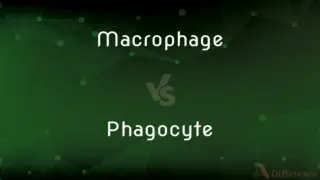Grub vs. Maggot — What's the Difference?
By Fiza Rafique & Maham Liaqat — Updated on March 14, 2024
A grub typically refers to the larval stage of beetles, characterized by a thick, soft body, whereas a maggot specifically denotes the larva of a fly, often found in decomposing matter, noted for its slender, worm-like appearance.

Difference Between Grub and Maggot
Table of Contents
ADVERTISEMENT
Key Differences
Grubs and maggots are both larval forms of insects but belong to different families and have distinct habitats and physical characteristics. Grubs, the larval stage of beetles (order Coleoptera), are often found in soil, feeding on plant roots or decaying wood. They have a C-shaped body, a distinct head, and are usually white or creamy in color. On the other hand, maggots, which are the larval stage of flies (order Diptera), are commonly found in decomposing organic matter, including rotting food and carrion. They have a tapered body, lack a visible head, and are known for their role in decomposition and the recycling of nutrients.
The lifecycle and developmental process of grubs involve metamorphosis from egg to larva, then pupa, and finally into an grown beetle. This process can vary in length, often lasting from one to several years, depending on the species and environmental conditions. Maggots, however, typically have a faster development cycle, transforming from eggs to larva and then pupa, before emerging as grown flies within a matter of days or weeks. This rapid lifecycle allows fly populations to increase quickly, especially in conditions where food sources are abundant.
Grubs are often considered pests in gardens and lawns, where their feeding can cause significant damage to plant roots, leading to yellowing, wilting, or even the death of plants. Effective grub control is crucial for maintaining healthy lawns and gardens. Conversely, maggots, despite their association with decay, play a crucial role in the decomposition process, breaking down lost material and recycling nutrients back into the ecosystem. They are also used in medical treatments for cleaning wounds (maggot therapy), where they consume waste tissue without harming living cells.
In terms of physical appearance, grubs are generally thicker and have a more robust body structure compared to maggots, which are slender and elongated. This difference in form reflects their respective lifestyles and feeding habits. Grubs, with their strong mandibles, are adapted to chewing through tough plant material or wood, while maggots, lacking such mouthparts, absorb semi-liquid food through their body surface.
While both grubs and maggots can be found in a variety of environments, their impact on their surroundings differs significantly. Grubs, as part of the beetle family, contribute to the health of the soil by aerating it and breaking down organic material. However, their destructive feeding habits can also negatively affect agricultural and horticultural practices. Maggots, on the other hand, are essential for the rapid decomposition of organic waste, preventing the spread of disease by consuming waste and decaying matter.
ADVERTISEMENT
Comparison Chart
Order
Coleoptera (beetles)
Diptera (flies)
Habitat
Soil, decaying wood
Decomposing organic matter
Body Shape
C-shaped, thick and soft
Slender, worm-like
Development Cycle
Varies, often 1-3 years
Short, days to weeks
Role in Ecosystem
Pest in gardens/lawns, soil aeration
Decomposition, nutrient recycling
Feeding Habits
Chew plant roots or decaying wood
Absorb nutrients from decomposing matter
Pest Status
Often considered pests in agriculture
Associated with decay, but beneficial for decomposition
Medical Use
None directly
Maggot therapy for wound cleaning
Compare with Definitions
Grub
The larva of a beetle, characterized by a thick, soft body.
The gardener found grubs damaging the roots of her plants.
Maggot
The larva of a fly, found in decomposing matter.
Maggots play a crucial role in breaking down lost tissue.
Grub
Often considered pests due to their damage to plants.
Effective grub control is essential for healthy lawns.
Maggot
Can develop rapidly, often in days to weeks.
The maggots quickly transformed into grown flies.
Grub
Varies in lifecycle length, typically 1-3 years.
The grub will metamorphose into a beetle over several months or years.
Maggot
Used in medical maggot therapy for wound cleaning.
Maggot therapy utilizes maggots to clean necrotic tissue from wounds.
Grub
Plays a role in soil health by aerating it.
Despite their pest status, grubs help in soil aeration.
Maggot
Known for their role in decomposition.
Maggots help recycle nutrients back into the ecosystem.
Grub
A C-shaped larval insect found in soil.
Grubs are common pests in lawns, feeding on grass roots.
Maggot
Slender and lacks a distinct head.
Maggots absorb nutrients through their body surface from semi-liquid food sources.
Grub
To search laboriously by or as if by digging; rummage.
Maggot
A maggot is the larva of a fly (order Diptera); it is applied in particular to the larvae of Brachycera flies, such as houseflies, cheese flies, and blowflies, rather than larvae of the Nematocera, such as mosquitoes and crane flies. A 2012 study estimated the population of maggots in North America to be in excess of 3×1017.
Grub
To dig up by or as if by the roots
Grubbed carrots with a stick.
Maggot
The legless, soft-bodied, wormlike larva of any of various dipteran flies, often found in decaying matter.
Grub
To clear of roots and stumps by digging
Grubbed a small plot.
Maggot
(Slang) A despicable person.
Grub
(Slang) To obtain by importunity
Grub a cigarette.
Maggot
(Archaic) An extravagant notion; a whim.
Grub
To dig in the earth
Grub for potatoes.
Maggot
A soft, legless larva of a fly or other dipterous insect, that often eats decomposing organic matter.
Grub
To toil arduously; drudge
Grub for a living.
Maggot
(derogatory) A worthless person.
Drop and give me fifty, maggot.
Grub
The thick wormlike larva of certain beetles and other insects.
Maggot
A whimsy or fancy.
Grub
A drudge.
Maggot
(slang) A fan of the American metal band Slipknot.
Grub
(Slang) Food.
Maggot
(transitive) To rid (an animal) of maggots.
Grub
(countable) An insect at an immature stage of its life cycle.
Maggot
The footless larva of any fly. See Larval.
Grub
Food.
Pub grub
Maggot
A whim; an odd fancy.
Grub
A dirty person.
Maggot
The larva of the housefly and blowfly commonly found in decaying organic matter
Grub
A despicable person; a lowlife.
Grub
(obsolete) A short, thick man; a dwarf.
Grub
To scavenge or in some way scrounge, typically for food.
Grub
(ambitransitive) To dig; to dig up by the roots; to root out by digging; often followed by up.
To grub up trees, rushes, or sedge
Grub
To supply with food.
Grub
To eat.
Grub
To dig in or under the ground, generally for an object that is difficult to reach or extricate; to be occupied in digging.
Grub
To drudge; to do menial work.
Grub
To dig; to dig up by the roots; to root out by digging; - followed by up; as, to grub up trees, rushes, or sedge.
They do not attempt to grub up the root of sin.
Grub
To supply with food.
Grub
The larva of an insect, especially of a beetle; - called also grubworm. See Illust. of Goldsmith beetle, under Goldsmith.
Yet your butterfly was a grub.
Grub
A short, thick man; a dwarf.
Grub
Victuals; food.
I 'd sooner ballads write, and grubstreet lays.
Grub
Informal terms for a meal
Grub
A soft thick wormlike larva of certain beetles and other insects
Grub
Ask for and get free; be a parasite
Grub
Search about busily
Common Curiosities
What is a maggot?
A maggot is the larval stage of a fly, known for its slender body and role in decomposing organic matter.
Are both grubs and maggots considered pests?
Grubs are often viewed as pests in gardens and lawns, whereas maggots are associated with decay but play a vital role in decomposition and nutrient recycling.
How do grubs and maggots differ in habitat?
Grubs are primarily found in soil or within decaying wood, while maggots thrive in decomposing organic matter, such as rotting food or carrion.
What is a grub?
A grub is the larval stage of a beetle, characterized by a C-shaped, soft body, typically found in soil or decaying wood.
How do maggots contribute to the environment?
Maggots are crucial for the decomposition process, breaking down lost material and recycling nutrients back into the ecosystem.
What is the lifecycle of a grub?
Grubs go through a metamorphosis from egg to larva, then pupa, and finally into an grown beetle, which can vary in length but often lasts from one to several years.
Can maggots have medical applications?
Yes, maggots are used in maggot therapy for wound cleaning, where they consume lost tissue without harming living cells.
What role do grubs play in the ecosystem?
Grubs contribute to soil health by aerating it and breaking down organic material, though they can damage plant roots.
How fast do maggots develop?
Maggots have a rapid development cycle, transforming from eggs to larva and then to pupa, before emerging as grown flies within a matter of days or weeks.
Why are maggots found in decomposing matter?
Maggots feed on decomposing organic matter, playing a key role in the decomposition process by breaking down and recycling nutrients.
Share Your Discovery

Previous Comparison
Macrophage vs. Phagocyte
Next Comparison
Pedestal vs. PodiumAuthor Spotlight
Written by
Fiza RafiqueFiza Rafique is a skilled content writer at AskDifference.com, where she meticulously refines and enhances written pieces. Drawing from her vast editorial expertise, Fiza ensures clarity, accuracy, and precision in every article. Passionate about language, she continually seeks to elevate the quality of content for readers worldwide.
Co-written by
Maham Liaqat















































